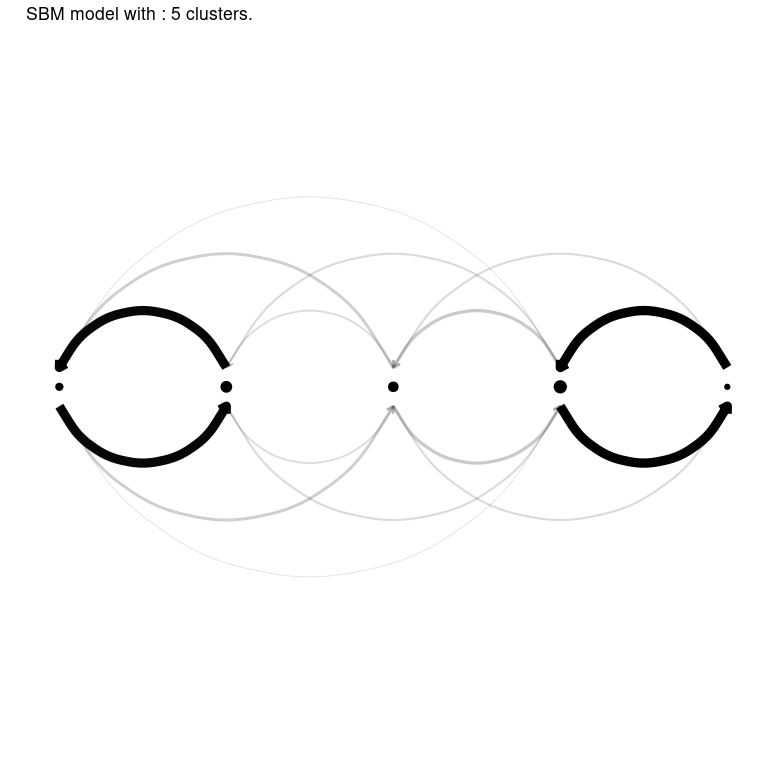Greed enables model-based clustering of networks, matrices of count data and much more with different types of generative models. Model-selection and clustering are performed in combination by optimizing the Integrated Classification Likelihood. Details of the algorithms and methods proposed by this package can be found in Côme, Jouvin, Latouche, and Bouveyron (2021) 10.1007/s11634-021-00440-z.
Dedicated to clustering and visualization, the package is very general and currently handles the following tasks:
- Continuous data clustering with Gaussian Mixture Models. A
GMM tutorial
is available. See also the documentation for the
GmmandDiagGmmS4 classes. - Graph data clustering with the Stochastic Block Model or its
degree corrected variants. A
SBM tutorial
is available . See also the documentation for the
SbmanddcSbmS4 classes. - Categorical data clustering with the Latent Class Analysis. An
LCA tutorial
is available. See also the documentation for the
LcaS4 class. - Count data clustering with the Mixture of Multinomials model. A
tutorial will soon be available. For now, we refer to the
documentation for the
MomS4 class. - Mixed-typed data clustering, e.g. categorical and numerical
but the package handles virtually any type of data combination by
stacking models on top of each data types. For example graph data
with continuous or categorical data attached to the nodes are
handled. A
CombinedModels
tutorial is available. See also the documentation for the
CombinedModelsS4 class. - Mixture of regression for simultaneous clustering and fitting a
regression model in each cluster. A
MoR tutorial
is available. See also the documentation for the
MoRS4 class. - Co-clustering of binary and count-data via the Latent Block
Model and its degree-corrected variant. A tutorial will soon be
available. For now, we refer to the documentation for the
DcLbmS4 class.
With the Integrated Classification Likelihood, the parameters of the models are integrated out with a natural regularization effect for complex models. This penalization allows to automatically find a suitable value for the number of clusters K⋆. A user only needs to provide an initial guess for the number of clusters K, as well as values for the prior parameters (reasonable default values are used if no prior information is given). The default optimization is performed thanks to a combination of a greedy local search and a genetic algorithm described in Côme, Jouvin, Latouche, and Bouveyron (2021), but several other optimization algorithms are also available.
Eventually, a whole hierarchy of solutions from K⋆ to 1 cluster is extracted. This enables an ordering of the clusters, and the exploration of simpler clustering along the hierarchy. The package also provides some plotting functionality.
You can install the development version of greed from GitHub with:
#GitHub
install.packages("devtools")
devtools::install_github("comeetie/greed")Or use the CRAN version:
#CRAN
install.packages("greed")The main entry point for using the package is simply thegreed function
(see ?greed). The generative model will be chosen automatically to fit
the type of the provided data, but you may specify another choice with
the model argument.
We illustrate its use on a graph clustering example with the
classical Books network ?Books.
More use cases and their specific plotting functionality are described in the vignettes.
library(greed)
data(Books)
sol <- greed(Books$X)
#>
#> ── Fitting a guess DCSBM model ──
#>
#> ℹ Initializing a population of 20 solutions.
#> ℹ Generation 1 : best solution with an ICL of -1347 and 3 clusters.
#> ℹ Generation 2 : best solution with an ICL of -1346 and 4 clusters.
#> ℹ Generation 3 : best solution with an ICL of -1346 and 4 clusters.
#> ── Final clustering ──
#>
#> ── Clustering with a DCSBM model 3 clusters and an ICL of -1345You may specify the model you want to use and set the priors parameters
with the (model argument), the optimization algorithm (alg argument)
and the initial number of cluster K. Here Books$X is a square sparse
matrix and a graph clustering ?`DcSbm-class` model will be used by
default. By default, the Hybrid genetic algorithm is used.
The next example illustrates a usage without default values. A binary
Sbm prior is used, along with a spectral clustering algorithm for
graphs.
sol <- greed(Books$X,model=Sbm(),alg=Seed(),K=10)
#>
#> ── Fitting a guess SBM model ──
#>
#> ── Final clustering ──
#>
#> ── Clustering with a SBM model 5 clusters and an ICL of -1255The results of greed() is an S4 class which depends on the model
argument (here, an SBM) which comes with readily implemented methods:
clustering() to access the estimated partitions, K() the estimated
number of clusters, and coef() the (conditional) maximum a posteriori
of the model parameters.
table(Books$label,clustering(sol)) %>% knitr::kable()| 1 | 2 | 3 | 4 | 5 | |
|---|---|---|---|---|---|
| c | 0 | 1 | 6 | 36 | 6 |
| l | 8 | 30 | 5 | 0 | 0 |
| n | 0 | 2 | 8 | 3 | 0 |
K(sol)
#> [1] 5
coef(sol)
#> $pi
#> [1] 0.07619048 0.31428571 0.18095238 0.37142857 0.05714286
#>
#> $thetakl
#> [,1] [,2] [,3] [,4] [,5]
#> [1,] 0.821428571 0.367424242 0.065789474 0.003205128 0.00000000
#> [2,] 0.367424242 0.106060606 0.006379585 0.003885004 0.00000000
#> [3,] 0.065789474 0.006379585 0.251461988 0.016194332 0.04385965
#> [4,] 0.003205128 0.003885004 0.016194332 0.099865047 0.42735043
#> [5,] 0.000000000 0.000000000 0.043859649 0.427350427 0.73333333An important aspect of the greed package is its hierarchical
clustering algorithm which extract a set of nested partitions from
K=K(sol) to K=1. This hierarchy may be visualized thanks to a
dendogram representing the fusion order and the level of regularization
− log (α) needed for each fusion.
plot(sol, type='tree') # try also: type="path"Moreover, similar to standard hierarchical algorithm such as hclust,
the cut() method allows you to extract a partition at any stage of the
hierarchy. Its results is still an S4 object, and the S4 methods
introduced earlier may again be used to investigate the results.
sol_K3 = cut(sol, K=3)
K(sol_K3)
#> [1] 3
table(Books$label,clustering(sol_K3)) %>% knitr::kable()| 1 | 2 | 3 | |
|---|---|---|---|
| c | 1 | 6 | 42 |
| l | 38 | 5 | 0 |
| n | 2 | 8 | 3 |
Finally, the greed package propose efficient and model-adapted
visualization via the plot() methods. In this graph clustering
example, the "blocks" and "nodelink" display the cluster-aggregated
adjacency matrix and diagram of the graph respectively. Note that the
ordering of the clusters is the same than the one computed for the
dendrogram, greatly enhancing visualization of the hierarchical
structure.
plot(sol,type='blocks')
plot(sol, type='nodelink')As explained above, the greed package implements many standard models and the list may be displayed with
available_models()Many plotting functions are available and, depending of the specified
model, different type argument may be specified. For further
information we refer to the vignettes linked above for each use case.
For large datasets, it is possible to use parallelism to speed-up the
computations thanks to the
future package. You only
need to specify the type of back-end you want to use, before calling the
?greed function:
library(future)
plan(multisession, workers=2) # may be increased


